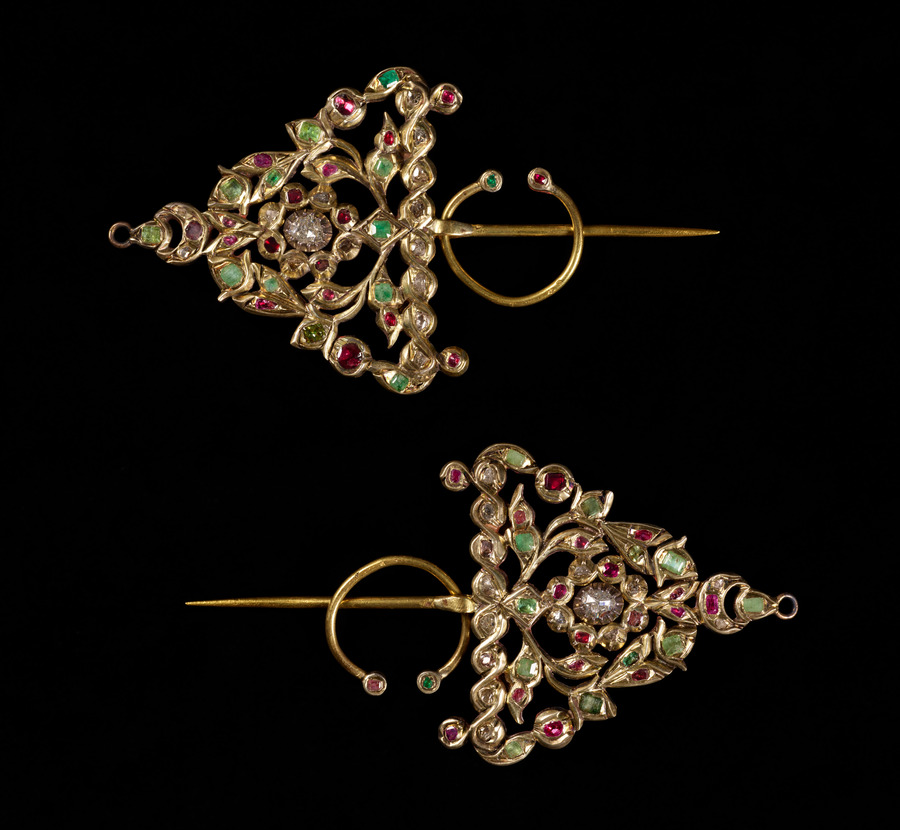
Arts of the Maghreb
Tags for: Arts of the Maghreb
- Magazine Article
- Exhibitions
North African textiles and jewelry at the CMA
Helina Gebremedhen, Leigh and Mary Carter Director’s Research Fellow
August 28, 2024
Appears in Cleveland Art, 2024, Issue 3

Throughout the 1800s, professional female embroiderers with the title of mu’allima (expert teacher) trained young Moroccan women in the techniques of their hometowns. Algerian Jewish jewelers exclusively fashioned gold and gemstones for an elite, urban clientele. Further east, Tunisian weavers made boldly striped textiles, skillfully working personal names and protective symbols into the cloth.
Arts of the Maghreb: North African Textiles and Jewelry spotlights these myriad arts of northern Africa from the 1800s to the early 1900s. Maghreb is an Arabic term meaning “the westernmost place” and is still used today to refer to modern Morocco, Algeria, and Tunisia. This exhibition introduces the region’s rich artistic traditions and multifaceted societies.
The exhibition originated during a comprehensive survey of the CMA’s collection of North African artworks, a major project of my role as Leigh and Mary Carter Director’s Research Fellow. As a PhD candidate specializing in African and Islamic art, I looked forward to working hands on with these artifacts and collaborating with internal and external colleagues. It quickly became clear that the little-studied CMA collection was actually quite representative of the Maghreb’s extensive artistic traditions. When the opportunity arose to curate an exhibition on this subject, I chose a selection that could introduce the visitor to this artistic, as well as cultural and geographic, diversity.
Image

In the gallery, four thematic groupings highlight the different artistic centers active during the 1800s and early 1900s. The iconic silver-and-enamel jewelry of the panregional Indigenous Imazighen (Ih-ma-zeer-en) peoples (historically known as Berber) greets the visitor at the entrance. A display of Moroccan embroideries showcases the representative styles of cities like Fes and Chefchaouen, the “Blue City.” Tunisian weavings and delicate veils and headdresses made in Algiers—as well as fine gold and gemstone jewelry—complete the display. The selection exemplifies the fine craftsmanship of North African artists through works used largely interchangeably by the Imazighen and Arab and the Muslim and Jewish communities in the region.
This geographic layout somewhat mirrors the travels of CMA founder Jeptha Homer Wade II and his family. On Christmas Day 1891, they landed in Tangiers, Morocco, kicking off a two-month voyage by boat, train, and carriage across northern Africa, where they extensively bought art. Poring through archives in Ingalls Library and digitized journals and photographs from the neighboring Western Reserve Historical Society, I began to understand the history of how these objects arrived at the CMA. One journal concisely notes the 1891–92 itinerary and its shopping trips. In a 1916 letter to the CMA’s first director, Frederic Whiting, Wade describes his wife Ellen Garretson Wade’s collection, assembled during travels “to the Orient” some 20 years prior, and offers to gift these objects to the CMA. Additional correspondence details the transfer of some works to the Education Art Collection.
The 1800s was also a time of profound political and social change, marked by the start of France’s invasions and colonialism in Algeria (1830), Tunisia (1881), and Morocco (1912). This upheaval profoundly impacted North African society, transforming cities, landscapes, and activities. New economic pressures forced many North Africans to sell their prized jewelry or flooded the local textile market with European imports, often made with American cotton. The colonial era also spurred new artistic modes, including the “Orientalist” style of idealized imagery—one example from the CMA’s collection is on view in the exhibition alongside the artworks of the era.
Image

To learn more about this historical moment, I traveled to France and Belgium in spring 2024, visiting other museums that address these complex artistic and political legacies. A research trip to Morocco in February allowed me to learn about new approaches and initiatives from researchers, docents, and collectors. One highlight was Rabat’s excellent National Museum of Adornment Musée National de la Parure, newly opened in a restored 11th-century fort. Finally, through visiting contemporary shops, reading about designers (such as Fatima el-Gadi), and meeting with organizations (such as the Timendotes Association) that are working to revive embroidery and weaving arts, I saw firsthand that this artistic heritage and the legacy of the mu’allima remain strong today.
Related Content
Arts of the Maghreb: North African Textiles and Jewelry
Tags for: Arts of the Maghreb: North African Textiles and Jewelry
- Special Exhibition
- Featured
This exhibition spotlights the rich artistic traditions of Morocco, Algeria, and Tunisia during the late 1800s and the early...
